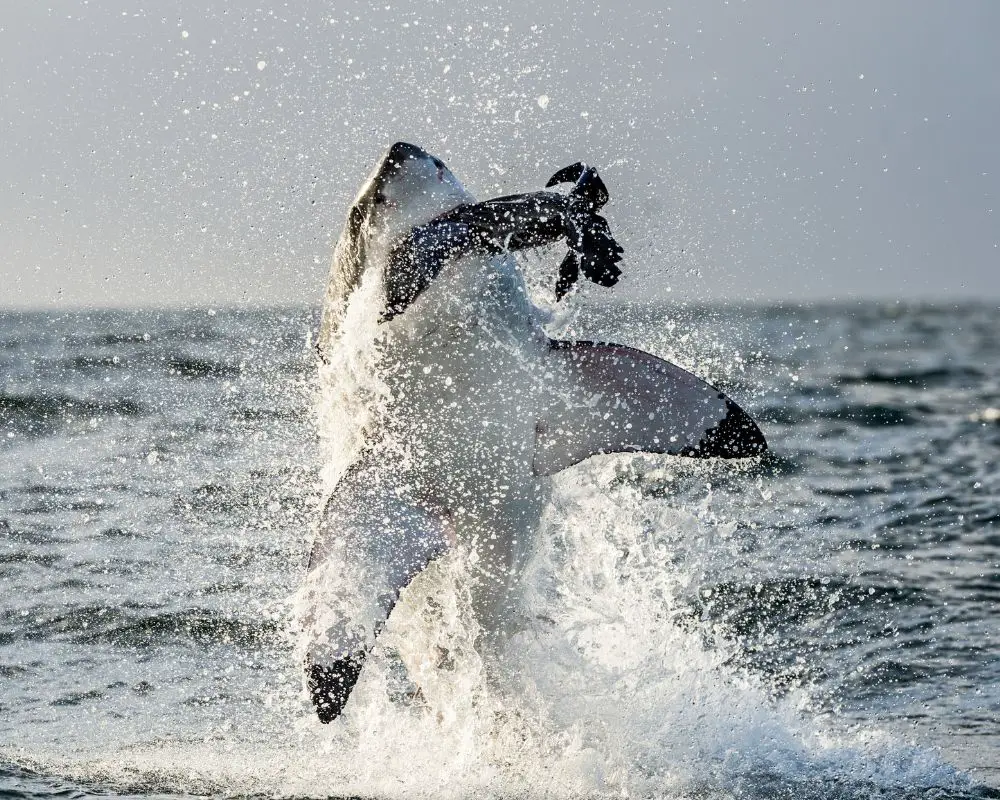Picture yourself swimming in the crystal-clear waters of a remote beach, enjoying the beauty of the ocean and the thrill of being surrounded by nature. Suddenly, you hear a splash behind you, and as you turn around, you see a massive shape coming toward you at an incredible speed. Before you even have time to process what’s happening, you realize that you’re face to face with one of the ocean’s most feared predators: a great white shark.
As terrifying as this scenario might seem, understanding how great white sharks attack and why they do it is crucial to staying safe in the ocean. These powerful creatures have a well-earned reputation as fierce predators, and their attacks on humans have been widely documented and sensationalized in popular media. However, as with any animal, there are specific factors that influence their behavior, and knowing these factors can help us reduce the risk of an encounter.
In this blog post, we’ll explore the fascinating world of great white shark attacks, discussing their hunting strategies, the physical attributes that make them formidable predators, and the environmental and human factors that influence their behavior. We’ll also examine the best ways to defend ourselves against a great white shark attack and the crucial role of marine conservation efforts in mitigating the risks associated with these powerful creatures.
Whether you’re an avid swimmer or simply fascinated by marine life, this post is a must-read for anyone interested in understanding how great white sharks attack and what we can do to stay safe in their natural habitat.
Great white sharks typically attack their prey by ambushing them from below at high speed, often launching themselves out of the water in a vertical breach. They use their powerful jaws and serrated teeth to bite their prey, then use their bodies to twist and tear off chunks of flesh. Great whites primarily hunt marine mammals, such as seals and sea lions, but will also prey on fish and seabirds.
And there is a related article you may be interested in How Do Great White Sharks Breach: The Whole Process?
Now, let’s dive into more details:
Anatomy of a Great White Shark Attack

Great white sharks are apex predators that are highly efficient hunters and are known to attack humans in certain situations. Understanding the hunting strategies and physical attributes that make these creatures formidable predators is crucial to understanding their behavior and reducing the risk of attacks.
The Hunting Strategies Of Great White Sharks
Great white sharks use a combination of sight, smell, and electroreception to locate their prey. They have excellent eyesight that allows them to detect prey from a distance, but they also rely on their sense of smell to locate prey from a greater distance.
In addition, they have a unique electroreception system that allows them to detect electrical fields emitted by living creatures.
To increase their chances of a successful attack, great white sharks rely on the element of surprise. They often approach their prey from below, where they are less visible, and then quickly swim upward to attack.
This ambush tactic is highly effective, and it is one of the reasons why great white shark attacks on humans often happen suddenly and without warning.
The Physical Attributes Of A Great White Shark That Aid In Hunting
Great white sharks are well adapted for hunting, with streamlined bodies and powerful muscles that allow them to swim at high speeds. Their powerful jaws and rows of sharp teeth are also critical to their success as predators.
The great white shark’s jaw can extend outwards, allowing it to open its mouth wider and take larger bites. Its teeth are serrated and razor-sharp, enabling it to tear through flesh and bone easily.
Great white sharks also have an incredibly strong bite force, with the ability to exert up to 18,000 newtons of pressure per square inch.
Examples Of Real-World Great White Shark Attacks And Their Outcomes
Great white shark attacks on humans are relatively rare, but when they do occur, the consequences can be severe. In 2019, there were 64 confirmed unprovoked shark attacks worldwide, and 41 of those attacks were attributed to great white sharks.
One example of a great white shark attack on humans is the attack on surfers at New Smyrna Beach in Florida. This beach is known for its high number of shark attacks, and in 2019, there were 16 reported attacks at the beach. In most cases, the attacks were relatively minor, with the surfers suffering only minor injuries. However, in some cases, the attacks have been more serious, resulting in significant injuries or even fatalities.
Another example of a great white shark attack on humans is the attack on a kayaker off the coast of California in 2017. The kayaker was fishing in Monterey Bay when a great white shark attacked his kayak, biting off the back end of the boat. Fortunately, the kayaker was not injured in the attack, but the incident highlights the potential danger that great white sharks can pose to humans.
Factors That Influence Great White Shark Attacks
While great white shark attacks on humans are relatively rare, it’s important to understand the factors that can increase the risk of an attack. By understanding these factors, we can take steps to minimize the risk of an encounter and stay safe in the ocean.
Environmental Factors
Environmental factors play a significant role in the frequency and severity of great white shark attacks. For example, warmer water temperatures can lead to an increase in the number of sharks in an area, as well as an increase in their feeding activity. Areas with high levels of fish populations, such as breeding or migration zones, can also attract large numbers of sharks and increase the risk of attacks.
In addition, factors such as water visibility, weather conditions, and the time of day can also influence the likelihood of a shark attack. Poor visibility due to murky water or low light conditions can make it more difficult for sharks to detect humans and increase the chances of a surprise attack. Similarly, rough or turbulent water conditions can make it more difficult for sharks to distinguish between prey and humans, leading to mistaken identity attacks.
Human Behavior
Human behavior can also play a significant role in the frequency and severity of great white shark attacks. For example, surfers and swimmers who enter the water during times of high shark activity or in areas with known shark populations are at a higher risk of an encounter.
In addition, certain activities, such as fishing or spearfishing, can increase the risk of a shark encounter. When fishing or spearfishing, humans are essentially chumming the water, which can attract sharks to the area. Similarly, wearing shiny or reflective jewelry or clothing can increase the risk of a shark attack, as the shiny objects can resemble the scales of fish and attract sharks.
Shark Behavior
Shark behavior can also play a role in the frequency and severity of attacks. For example, juveniles and subadults are more likely to make mistaken identity attacks, as they are still learning to identify their prey. Similarly, sick or injured sharks may be more likely to attack humans, as they may have difficulty catching their usual prey.
Great white sharks are also more likely to attack humans who are alone, as groups of humans can be intimidating to the sharks. In addition, sharks are more likely to attack from below or behind, where they are less visible to their prey.
Mitigating The Risk Of Great White Shark Attacks
There are several steps that individuals can take to minimize the risk of a great white shark attack. These include avoiding areas with high levels of shark activity, such as breeding or migration zones, and being aware of the time of day and weather conditions when entering the water.
In addition, individuals can reduce the risk of a shark encounter by avoiding behaviors that can attract sharks to the area, such as fishing or spearfishing, and by not wearing shiny or reflective jewelry or clothing. When entering the water, it’s also important to do so in a group, as this can help to deter sharks from approaching.
How To Survive a Great White Shark Attack?
While great white shark attacks on humans are rare, it’s important to know how to defend yourself in the event of an encounter. By following these tips, you can increase your chances of avoiding an attack or surviving one.[1]
Prevention Is The Best Defense
Prevention is the best defense against great white shark attacks. The following tips can help to reduce the risk of an attack:
- Avoid swimming in areas known to have a high population of sharks or where there have been previous shark attacks.
- Do not enter the water if you are bleeding or have an open wound, as sharks can smell blood from great distances.
- Avoid wearing shiny or bright clothing, as this can attract sharks.
- Avoid swimming in areas where there is commercial or recreational fishing, as this can attract sharks to the area.
Shark Repellents
There are a variety of shark repellents available on the market, such as electronic devices or chemical repellents. However, it’s important to note that the effectiveness of these repellents is still under study and there is no guaranteed way to repel a great white shark.
Use Your Environment
In the event of an attack, it’s important to use your environment to your advantage. The following tips can help increase your chances of survival:
- Fight back aggressively by hitting the shark’s nose, eyes, or gills, as this can cause the shark to release its grip.
- Use any nearby objects to defend yourself, such as a surfboard or a rock.
- Try to stay calm and control your breathing, as rapid movement and splashing can attract more sharks to the area.
FAQs
How Often Do Great White Sharks Attack Humans?
Great white shark attacks on humans are rare, with an average of only 80 unprovoked attacks per year worldwide. However, when attacks do occur, they can be severe and often fatal.
What Causes A Great White Shark To Attack?
There are several factors that can cause a great white shark to attack, including:
1. Mistaking a human for its natural prey, such as a seal or sea lion
2. Defensive behavior, such as protecting its territory or young
3. Curiosity or investigative behavior
4. Provoked attacks, such as when a shark is caught on a fishing line or provoked by a diver or swimmer.
How Aggressive Is A Great White Shark?
Great white sharks are apex predators and can be highly aggressive when hunting prey. However, they do not typically see humans as prey and are often cautious or curious when encountering them. The level of aggression can vary depending on the situation and the individual shark, but attacks on humans are rare and typically not predatory in nature.

